South First pored over several documents, articles recorded in the run-up to the eve of the first Independence Day to trace the true story of this Sengol.
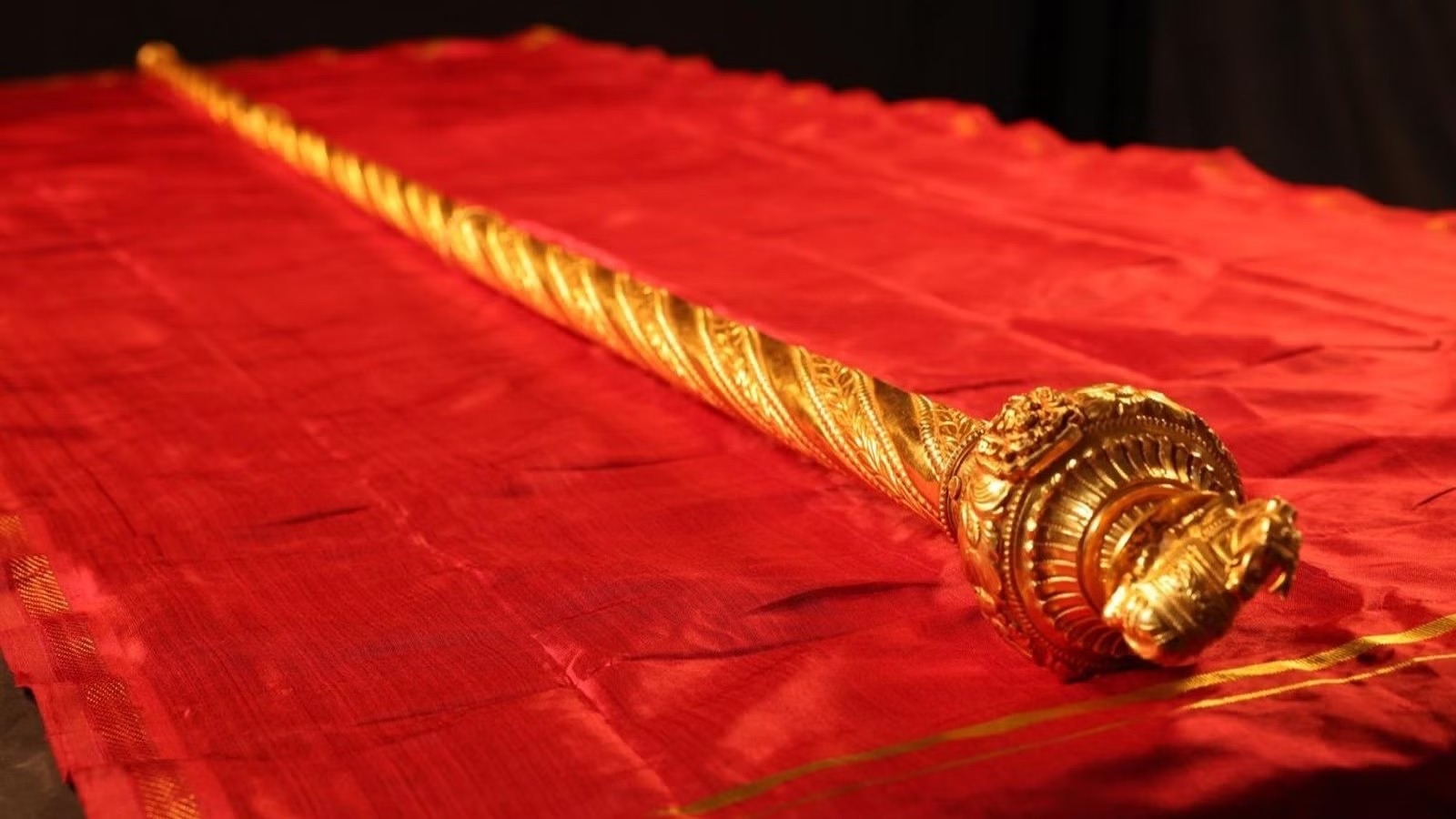
The debate over Prime Minister Narendra Modi inaugurating the newly-built Parliament building, the boycott of Opposition parties, and leaving out President Droupadi Murmu and Vice-President Jagdeep Dhankhar — who is also the chairman of the Rajya Sabha — for the inauguration ceremony on Sunday, 28 May, have raised the temperature in the political arena in the national capital.
Apart from all these, the “Sengol” — a sceptre given to Jawaharlal Nehru minutes before the proclamation of independence symbolising, as the Modi government claims, the transfer of power — has become an accoutrement for the moment.
On Wednesday, 24 May, Union Home Minister Amit Shah announced that the sceptre, which is said to have roots in the Chola dynasty, would be installed in the new Parliament building.
Further, the government has created a separate website to highlight the significance of the “Sengol”. It that can be read in 13 languages.
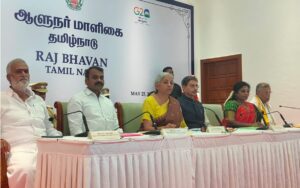
Finance Minister Nirmala Sitharaman briefing on Sengol at a pressmeet in Chennai
The next day, Finance Minister Nirmala Sitharaman, Minister of State for Information and Broadcasting L Murugan, Governors RN Ravi, Tamilisai Soundararajan, and Ela Ganesan addressed reporters in Chennai, underlining the significance of installing the Sengol in the newly-built Parliament building.
Sitharaman said that until noted Bharatnatyam dancer Padma Subrahmanyam wrote a letter to Prime Minister Modi, there was no cognizance that such a Sengol existed.
The minister added that after a wide search, it was found in the museum of Anand Bhavan in Prayagraj.
While there is ample evidence that the Sengol was given to Nehru, most other claims of the Modi government around the Sengol don’t add up.
South First pored over several documents, articles, records — and spoke to several experts — to trace the true origins of this Sengol.
That the Sengol was given to Nehru has been recorded by several news articles in August 1947.
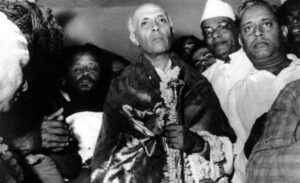
Nehru with the Sengol gifted by Aadheenam
Documentation of the Sengol being handed to Nehru also finds mention in the book Thiruvaduthurai Aadheena Varalaaru, written by S Krishnasamy, who is also a renowned epigrapher.
On page 153, under the sub-head “Patriotism”, the author says that “the seer of the Thiruvaduthurai Mutt Ambalavana Deshikar gave a Sengol with a Rishabha Vaghana — a symbol of Saivite culture — to his second-in-command seer, Kumaraswamy Thambiran, the Mutt Odhuvar (singer) Manickam, and the Nadaswaram vidwan (scholar/expert) TN Rajarathinam Pillai to go to Delhi and hand over the ‘Sengol’ to Nehru after reciting a hymn from Kolaru Padhigam – Thirumurai. Thus he displayed his patriotism.”
Ambalavana Deshikar, being the Saivate head seer, would have been referred to as the Aadheenam.
Seer Ambalavana Deshikar had given the order for making the Sengol to Chennai-based jeweller siblings Vummidi Ethirajulu and Vummidi Sudhakar.
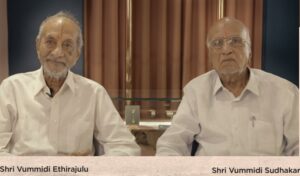
Vummidi Ethirajulu and his brother Vummidi Sudhakar
The seer gave a detailed description of the Sengol. And the goldsmiths made the Sengol accordingly.
Shailesh Raj Vummudi, partner of Vummudi Bangaru Chetty & Sons, the jewellers who made the Sengol, told South First that the sceptre is made up of 22-carat gold and according to government data, nearly half a kilogram of gold is used, in addition to silver.
“Our forefathers have no connection with the Tiruvaduthurai Aadheenam, and it was a business order. Since we have been operating since 1900 and are reputed, the Aadheenam might have given the order,” he said.
He added that it would have taken at least a month to make such a sceptre, which indicates the order might have been given in the month of June or July in 1947.
“We became aware that such a Sengol existed only after seeing an article in a Tamil magazine and searching for the Sengol. We later found that the Sengol was kept in a museum in Ahmedabad,” Vummudi said.
All the designs and descriptions on the Sengol were given by the then Aadheenam, he added.
Retired history professor and anthropologist K Vijay Anand said that a sengol or sceptre is a symbol of royalty and power.
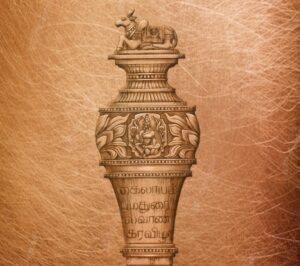
The Sengol with Nandhi – a symbol of Saivate
The professor told South First: “Every kingdom had its own sceptre. A Sengol signified the transfer of power only when it happened hereditarily. For example, if the king was bedridden or dead, his sceptre would be given to his son as a mark of transferring power. But when a king took over another kingdom by war or any other means, he would not use the sceptre of the old or defeated king. There are references to the sceptre even in the Bible and ancient Tamil literature.”
He said that the Sengol given to Nehru did not have any religious symbolism.
“The Sengol was given by a Saivate seer, and the Nandi [a cohort of Siva often depicted as a bull] on top of it represented the Saivite culture, not the Hindu religion or a symbol of justice. If it had roots in the Chola dynasty, the Sengol would definitely have had a tiger symbol marked on it,” he explained.
He further said: “Nowhere in a democracy — in any country — is the sceptre used by any leader as a symbol of justice or power. Everyone knows Nehru was a socialist and would not be idealistic about the sceptre. Since the Sengol was given in an individual capacity at his residence, Nehru might have taken it as a gift and would have sent it to the museum.”
Anand further said that there were examples in this country where former Presidents had taken gifts given to them while they left office.
Fauji Akhbar, the weekly newspaper published by the Indian Army (now christened Sainik Samachar), is the oldest defence journal in the country, being published since 1909.
In its special issue dated 30 August, 1947, it carried a detailed account of the happenings around Independence Day, and nowhere did it mention the ritual of “transfer of power” through the Sengol.
The newspaper said the formal ceremonies, carefully rehearsed, had to be abandoned.
Phillips Talbot, then South Asia correspondent for the Chicago Daily, was a witness to the historic day.
In a letter (which was published in Rediff.com) addressed to his friend Walter S Rogers of the Institute of Current World Affairs in New York, Talbot described the Independence celebrations in Karachi and Delhi, where there was no mention of power transfer using the Sengol.
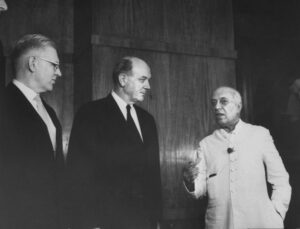
Philips Talbot (Left Extreme) with Nehru
“Some days earlier astrologers had discovered that the morning of August 15-the day designated for the transfer of power was an inauspicious time. Partly for this reason and partly because they were well aware of the drama of the occasion, Congress leaders decided on a midnight session of the Indian Constituent Assembly to assume authority at the stroke of 12.
The programme was carried out to the letter inside the brightly-lit hall. New national flags — saffron, white and green with a blue Ashoka wheel of life in the center — hung in the chamber and against the wall panels that formerly held portraits of British viceroys. All India Radio and the BBC had their microphones and sound cabins in place. Guests crowded the galleries and overflowed onto the sides and back of the floor. Members’ families, diplomats, officials, press men, and all others who could wangle tickets were there.
Inspired by the date, the hour and the crowd, Jawaharlal gave another and perhaps the best of the sensitive, heart-warming, destiny-conscious speeches that have marked his public life this year… As the chimes of midnight were broadcast an excited Hindu member blew the conch to call the gods to witness the occasion. All members rose at the same moment to pledge themselves to the service of India, and the Assembly was duly declared the sovereign body of the just-born Dominion.
That was the scene inside the Assembly chamber…” (Sic)
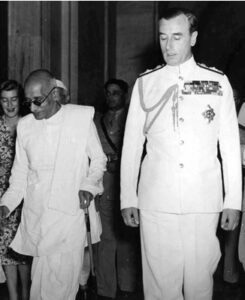
Rajaji with Mountbatten
According to the government website, Nehru asked C Rajagopalachari — aka Rajaji, the last governor-general of India — the ways to transfer power, and Rajaji sought the advice of the Kanchi seer. On his advice, Rajaji approached the Thiruvaduthurai Aadheenam.
There are 34 books on and by Rajaji. After 1947, Rajaji himself penned seven books and delivered speeches on various platforms.
Yet, nowhere is he known to have mentioned the “transfer of power through Sengol” or his role in getting a Sengol made through the Thiruvaduthurai Aadheenam.
In a recent column by Rajmohan Gandhi in NDTV, he wrote: “If I am allowed a personal comment before making a couple of broader points, let me, as Rajaji’s grandson and biographer, state that before the reports of Home Minister Shah’s press conference appeared in the media, I had never heard of Rajaji’s purported role in the Sengol story. Since the 1947 story is new to many, and not just to me, I hope that documents that confirm the roles in the story ascribed to Mountbatten, Nehru and Rajaji are made public as soon as possible. It would be good for the government’s credibility.
According to government data and the version of the Thiruvaduthurai Aadheenam, they handed over the Sengol by 11.45 pm on 14 August to Nehru at his residence.
Before that, the incumbent government as well as the current Aadheenam claim that the representatives met Mountbatten and handed over the sceptre to him and then took it back, sprinkled it with water from the holy Ganga river, and took it to Nehru’s house in a procession.
In 1947, Mountbatten was staying at the Viceroy’s House, which was later renamed Rashtrapati Bhavan.
Nehru stayed at 17 York Road (now Moti Lal Nehru Road), a Lutyen’s Zone bungalow, before shifting to Teen Murti Bhavan. The distance between the two houses is nearly 2 km.
According to the archive of the University of Southampton, which protects the documents of Lord Louis Mountbatten, all the visitors to the viceroy were documented until he left office.
South First, after an intensive search, found that there was no mention of any seers meeting Mountbatten between 15 July and 15 August, 1947.
The official itinerary of Mountbatten, which was charted on 10 July, 1947, showed that he was in Karachi on 14 August and returned to Delhi Airport on the same day around 7 pm.
Later, he proceeded to the Viceroy’s House in a procession.
In the book Mountbatten and the Partition of India, a series of candid interviews with Lord Mountbatten, who described every single step in the power transfer, recalls the incidents with Larry Collins and Dominique Lapicrre.
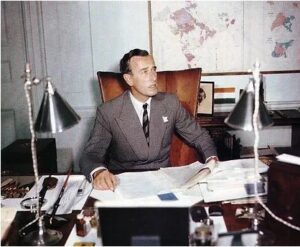
Lord Mountbatten at his desk in Viceroy’s House
Describing the events of 14 August evening, after he returned from Karachi, in Part 1 of 110 interviews, Mountbatten said: “We started off, therefore, with a very dramatic midnight meeting And I sat there, signing the last telegrams as a Viceroy, and then Nehru came in, as the man I’d chosen as Prime Minister, and the President of the Congress Party, who was really the President of the Assembly, Rajendra Prasad and I wouldn’t have a lot of photographers, perhaps there were one or two.”
When asked about what his very last act as Viceroy of India was, Mountbatten said that he had been working for some time on a genealogical tree of his family.
Mountbatten answered several questions regarding the transition of power.
Q. People were amazed at the speed of your transition to Governor-General from Viceroy.
A. Everything was ready to occur at midnight We swapped the thing over, we pulled down the Union Jack and put up the blue Governor-General’s flag which I had, myself, more or less, designed.
Q. Did you pull down the flag yourself ?
A. No, it happened automatically. The flag changed to a dark-blue flag with a golden cypher.
Q. Did you go down and watch the flag come down?
A. No, no, it happened at midnight. The Indian flag was hoisted.
At the Colour Ceremony I insisted that the Union Jack should not be hauled down There was a bare flag-pole on which this was hoisted. The Union Jack didn’t disappear, don’t forget It was still used, on holidays and great days and even now, they very often fly the Union Jack. You can see the flag of the last Viceroy of India in the Romsey Abbey the Union Jack with the Star of India in the middle. That was hauled down at midnight and replaced by the dark blue flag with the cypher.
Q. Do you remember Nehru’s toast that night?
A. I do remember. But he said “King George the Sixth,” not the King of England. It’s a crucial difference. He’s being a loyal dominion leader. I said then, “To India ”
Considering he never drank, to drink port at 2 in the morning, in a toast to the King, at the dawn of India’s independence, was quite something.
The account of Mountbatten clearly states that he had not met any seers, and that he had considered the transition of power would be denoted by lowering the Union Jack flag and putting up the blue Governor-General’s flag, which he himself had designed.
It is to be noted that in the whole interview, there was not even a mention of the transfer of power through a sceptre.
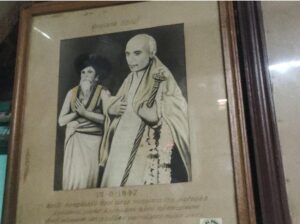
A framed photo displayed at Thiruvaduthurai Aaadheenam
On Friday, 27 May, reporters asked the current Thiruvaduthai Aadheenam Ambalavana Desika Paramacharya Swami about the handing over of the Sengol to Mountbatten.
The seer replied that there were not many photographers available at that time.
However, the account of Mountbatten states that he had two photographers with him on the evening of 14 August.
The Aadheenam has only one photograph, that of the handing over of the Sengol to Nehru. There is no documentary evidence, even with the Aadheenam, that the Sengol was ever given to Mountbatten and taken back.

Apr 27, 2024

Apr 26, 2024

Apr 26, 2024

Apr 26, 2024

Apr 25, 2024

Apr 25, 2024